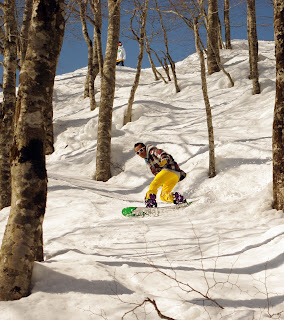I may sound redundant, but what a great day! And we didn’t even go skiing. This time Chen and his wife Vivian, themselves Chinese but locals to the Bandai area, took us for a tour around the Aizu area; that is, the area that Alts Ski Area overlooks on a clear day.
Our first stop was Lake Inawashiro, the fourth largest lake in Japan. There we got up close with nature — we played amongst, and fed, the ducks and swans gathered along the lakeshore. We bought some bread and immediately we had hundreds of new web-footed friends. They ate right from our hands.
After the lake, we headed to Aizu Wakamatsu, the largest city (about 150,000 people) near Alts Ski Area. There we checked out the Tsuruga-jo Castle. The history of the castle goes back 600 years, but the present one is a remake of one built 400 years ago. Aizu Wakamatsu was renowned for its samurai.
The most famous samurai story goes thusly: About 140 years ago the Meiji government went to war with the Aizu samurai to reestablish its rule in the region. Twenty young samurai called the White Tigers, all of them between 16 and 17 years old, witnessed the battle for the Tsuruga-Jo Castle from a hillside. The smoke was terrible and it seemed the castle was already burning to the ground. In despair, they committed suicide rather than surrender, disemboweling themselves in a ritual called sepuku. It turns out the teenage warriors were rash — victims of their impatient youth. Only the surrounding area was burning; but the thick smoke made it appear as if the castle had fallen. In fact, it was holding strong and didn’t fall until weeks later. One of the young samurai survived to tell the story of the White Tigers.
From the castle, we headed to a neighboring city called Kitakata. The city is famous for its ramen noodles as well as its hundreds upon hundreds of kuras, or small shops/warehouses. People live in the kuras, sell wares or food products from them, and even brew sake. In the Ohara Brewery, we sampled some fantastic sake. They say the flavor owes to their special recipe. The brewery follows the traditional rules of sake production, with one exception. Apparently, the brewers discovered that “playing music increases the fermentation activity of the yeast." Music also helps more of the yeast survive and keep the flavor clear of dead yeast. Happy yeast makes for good sake.
And what music do they play you ask? Hip hop? Funk? Kenny G? AKB48?
The answer:
Mozart.











